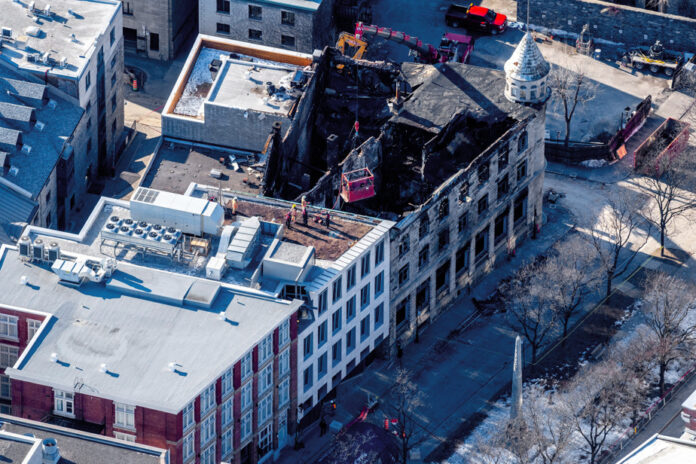(Montreal) The body of a fifth victim was extricated late Saturday afternoon from the rubble of the building in Old Montreal destroyed by fire more than a week ago.
Members of the Montreal Fire Department’s Technical Rescue Group made the discovery as they continue their search inside the building based on sketches of the building and information gathered by police officers, said said officer Véronique Dubuc of the Montreal Police Service.
The body was entrusted to the Laboratory of Forensic Sciences and Forensic Medicine to proceed with the identification of the person.
Four bodies had already been found earlier this week. Two people are still missing.
Testimonials from former tenants and victims of the Old Montreal building destroyed by the March 16 fire raise questions about the safety of the premises.
This is not the first time that the owner, Emile-Haim Benamor, has had trouble with his tenants.
In 2012, before the Régie du logement (now Administrative Housing Tribunal), he invoked “risks of electrical overload” created by a tenant in a request for termination of the lease against him.
Mr. Benamor had claimed that the tenant in question had “modified or added” electrical systems and overloaded the building’s circuits.
“The landlord insists that in the current state of things, the building is not profitable, he is unable to have access to the accommodation, even more so to the various appliances, that there is a risk of fire and it says it is monitored by insurance, especially since it is a historic building,” the court ruling reads.
The owner also called a witness from Lloyd’s insurance company, who said the unit had security issues. In an affidavit included in the court’s decision, Michel Frigon claimed that the unit was not originally intended to be an apartment, but rather a storage area. Mr. Frigon noted that access to the unit was required to perform maintenance on the building’s heating and electrical systems.
“The shower next to the electrical entrance to the house presents a real danger of electrocution,” he added, adding that a new insurer would probably have to be found if the problems were not resolved.
But in her written decision, administrative judge Jocelyne Gascon concluded there was little convincing evidence to suggest the tenant, Piotr Torbicki, was responsible for any electrical issues.
“The various electrical systems, although appeared to the Tribunal to be non-compliant, obsolete, the evidence offered did not establish that they were recent additions,” she wrote. She did not express an opinion on Mr. Benamor’s comments regarding the fire hazard.
The William-Watson-Ogilvie Building was built in 1890 and originally housed the offices of a flour company. It was gradually converted into a dwelling between the late 1960s and the 1980s, with an architecture firm remaining on the ground floor. Municipal property records show that Mr. Benamor, a lawyer, purchased the building in 2009.
A fire survivor, Alina Kuzmina, said that although the unit she rented with her husband in the semi-basement had fire alarms, she does not recall hearing them go off. Ms. Kuzmina was able to escape from the building by breaking a window.
The owner responded this week through his lawyer, Alexandre Bergevin, saying the alarm system had been replaced in 2019 and was regularly tested. Regarding the emergency exits, the lawyer indicated that the architecture of the building is complex.
“It’s always been deemed compliant in the past,” he said in a text.
A former tenant spoke on condition of anonymity, saying he feared reprisals from Mr. Benamor, who owns several buildings in the city. The witness said that in recent years, long-term tenants have gradually left the premises and their accommodations have become rental units on the Airbnb platform. He also said some units had been subdivided and at least one had no window.
Me Bergevin said in an interview Friday that the short-term rentals in the building were the work of tenants and not of his client. He alleged that one particular individual was renting seven units in the building and listing them “illegally” on Airbnb. He said Mr. Benamor had instructed the offending person to stop the short-term rentals and that they had come to an agreement that she vacate the building by July 1.
The attorney acknowledged that one apartment in the building “didn’t have a window in the traditional sense,” but did have a skylight.
When asked if the smoke detectors worked, he replied, “That’s a great question. We do not know yet. But he argued that there were detectors in all the apartments, that the central detector was working the day before the fire and that it would be surprising if they all failed.
Bergevin said he was not aware of any specific electrical issues, including those raised in the Régie du Logement’s 2012 decision, but noted that the building dates from the 19th century.
“It’s definitely not the electricity we know today,” he noted, adding that at times when problems arose, qualified electricians worked in the building.
Mr. Benamor, he said, has felt attacked since news of people dying in the blaze.
“The People’s Court, while we have no idea what caused the fire, is causing him a lot of psychological distress,” he said.


















